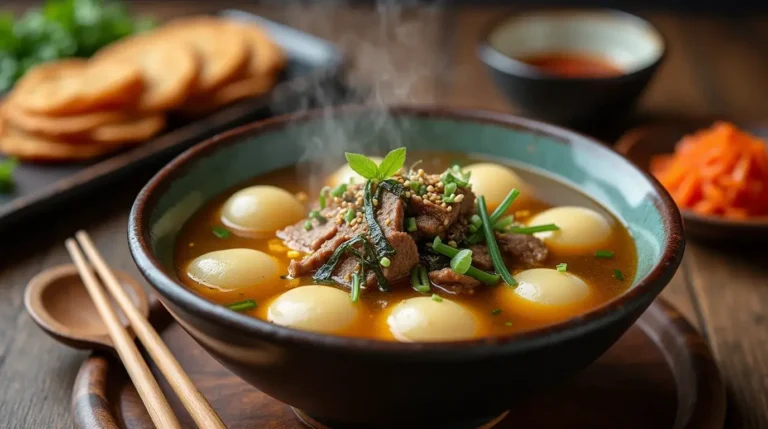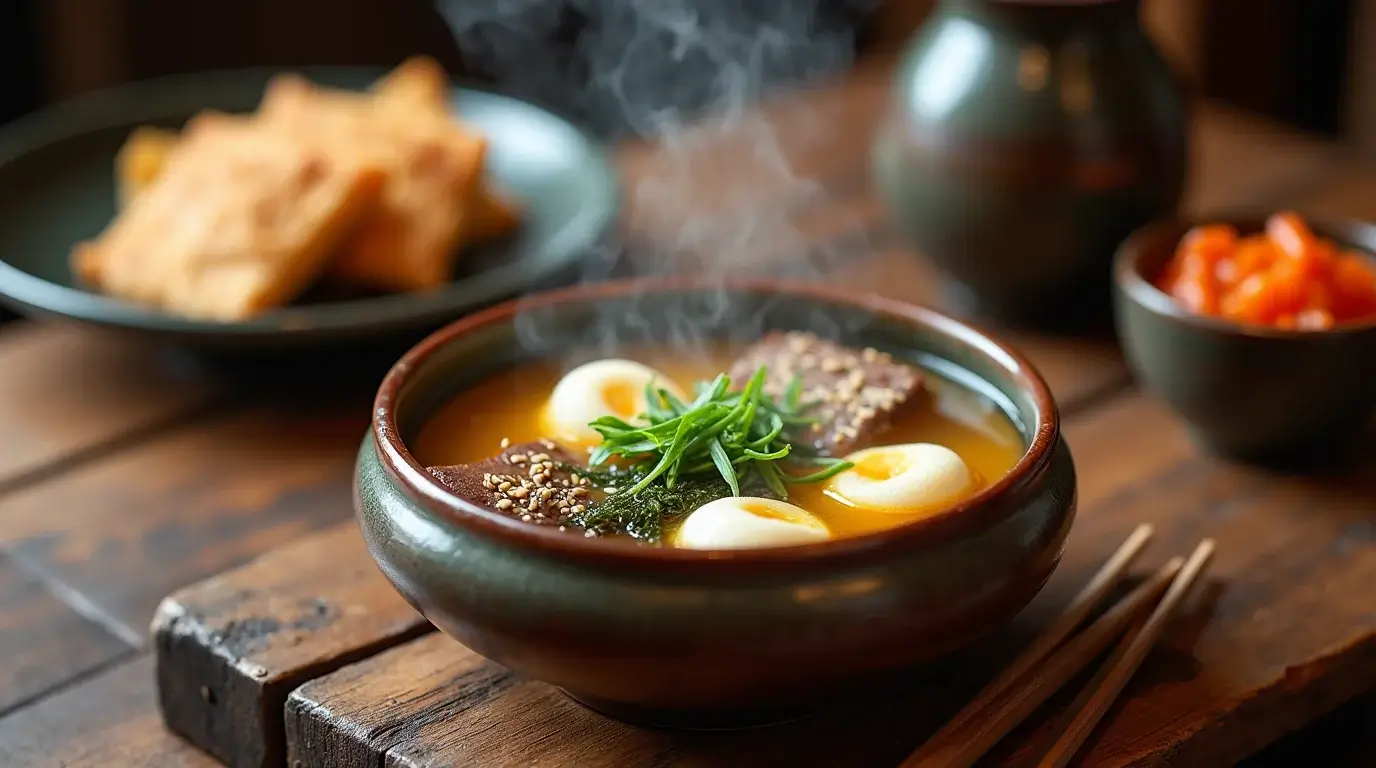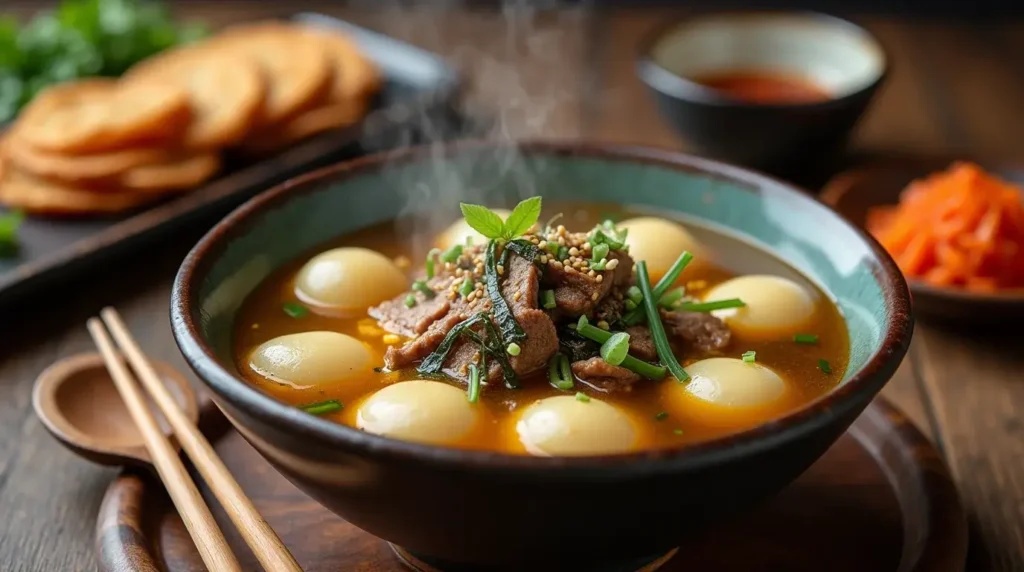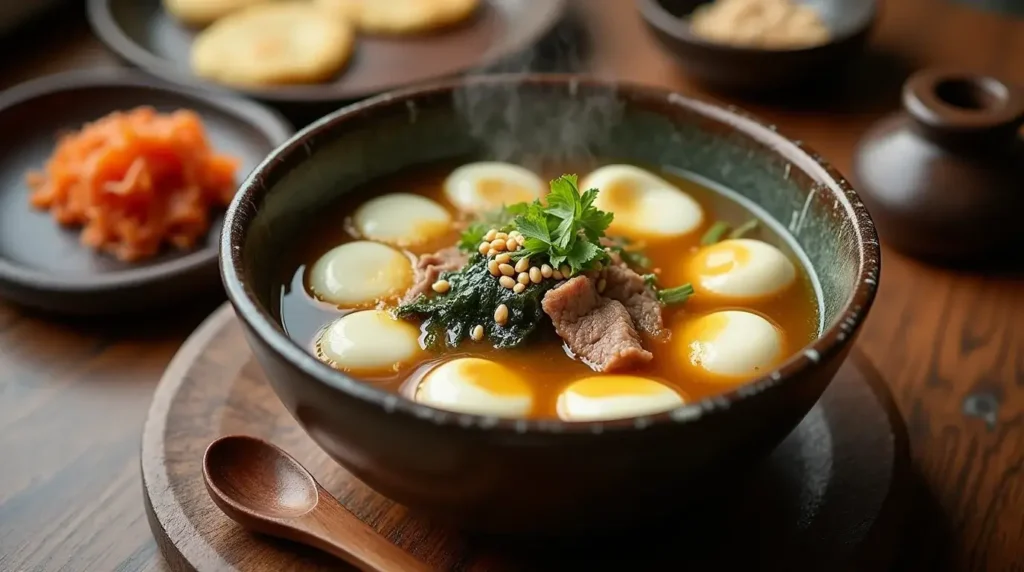Introduction & History
Korean rice cake soup (Tteokguk) is a traditional dish made with sliced rice cakes (tteok), simmered in a savory broth, and garnished with egg ribbons, seaweed, green onions, and sometimes beef or dumplings. This warm and comforting dish is an essential part of Korean cuisine, known for its chewy texture, delicate flavors, and nourishing qualities.
Tteokguk holds deep cultural significance in Korea, especially during the Lunar New Year (Seollal). It is believed that eating a bowl of this soup on New Year’s Day brings good fortune and symbolizes a fresh start. The white, coin-shaped rice cakes represent purity and prosperity, while the act of consuming the dish is said to add one year to a person’s age, following the Korean tradition of aging collectively on Seollal.
Beyond its New Year’s association, Korean rice cake soup is enjoyed throughout the year, offering a simple yet satisfying meal for many Koreans. While traditionally made with beef or anchovy broth, modern variations include vegetarian, spicy, and seafood-based versions. Whether eaten for its cultural significance or simply as a delicious comfort food, Tteokguk remains a beloved staple in Korean households.
The History and Cultural Significance of Tteokguk
Origins of Rice Cake Soup in Korea
Tteokguk dates back to Korea’s early dynastic periods, with historical references found in the Joseon Dynasty (1392–1897). Rice cakes (tteok) have long been a staple in Korean cuisine, often associated with special occasions and ancestral rites. Early records suggest that Tteokguk was enjoyed as a festive dish, particularly during the Lunar New Year (Seollal), marking a symbolic new beginning.
Evolution of the Dish Over Centuries
Throughout history, Tteokguk evolved based on regional preferences and ingredient availability. The classic version, made with a light beef broth, was favored in royal courts, while in coastal regions, seafood-based broths became common. Today, many households put their own spin on the dish, using ingredients like dumplings (mandu), chicken broth, or even spicy gochujang to enhance the flavors. If you’re interested in comforting soups beyond Korean cuisine, try this Marry Me Chicken Soup Recipe for a creamy and rich alternative.
Symbolism of Tteokguk: Longevity, Purity, and New Beginnings
Tteokguk carries deep symbolic meaning in Korean culture:
- Longevity: The long, cylindrical rice cakes (before slicing) symbolize a long and prosperous life.
- Purity: The white color of the soup represents a fresh start and cleanliness.
- New Beginnings: Eating a bowl of Tteokguk on New Year’s Day is believed to “add one year to your age”, aligning with Korea’s unique age-counting system.
Many Koreans enjoy Tteokguk as a breakfast option during Seollal, and if you’re looking for a simple yet delicious breakfast dish, consider pairing it with this Perfect Fried Egg on Toast Recipe. Additionally, for those with dietary restrictions, there are ways to make Tteokguk gluten-free. You might find this Gluten-Free, Dairy-Free, Sugar-Free Diet Guide helpful when modifying the recipe to suit your needs.
Tteokguk remains a timeless dish, blending cultural heritage with culinary evolution, and continues to be cherished as a comforting meal throughout the year.
Traditional vs. Modern Variations of Tteokguk
Traditional Recipe: A Classic Korean New Year Dish
The traditional Tteokguk recipe is a simple yet flavorful dish that has been enjoyed in Korea for centuries. It typically consists of:
- Broth: A rich, clear beef broth made by simmering brisket or bone-in beef with garlic and green onions.
- Rice Cakes (Tteok): Thinly sliced, oval-shaped garaetteok (cylindrical rice cakes) that soften in the hot broth.
- Egg: Beaten eggs, either drizzled into the soup or cooked into thin ribbons.
- Seasoning & Garnishes: Soy sauce, sesame oil, and black pepper enhance the flavor, while shredded beef, seaweed (gim), and chopped green onions add texture and depth.
This classic version is commonly eaten during Seollal (Lunar New Year’s Day) and is said to bring good fortune and longevity.
Modern Adaptations: New Twists on a Classic
With evolving tastes and dietary preferences, Tteokguk has seen many modern adaptations:
- Vegetarian Tteokguk: Uses vegetable or kelp broth instead of beef, often adding mushrooms for umami depth.
- Chicken Broth Tteokguk: A lighter version made with shredded chicken, offering a milder flavor.
- Spicy Tteokguk: Incorporates gochujang (Korean red chili paste) or kimchi for a bold, fiery twist.
- Tteok Mandu Guk: A popular variation that includes Korean dumplings (mandu) for extra heartiness.
If you love the idea of dumpling-filled soups, you might enjoy this Marry Me Chicken Soup Recipe for another comforting bowl.
Regional Differences in South Korea
Tteokguk varies across different regions:
- Seoul & Central Korea: The classic beef broth version is the most common.
- Jeolla Province: Often includes oysters or seafood in the broth.
- Busan & Southern Regions: Frequently made with anchovy or seafood broth, giving it a lighter, brinier flavor.
- North Korea: Uses shorter, thicker rice cakes, creating a chewier texture.
No matter the variation, Tteokguk remains a beloved dish that brings comfort, nostalgia, and warmth to Korean households. If you’re looking for another cozy breakfast pairing, consider serving it with this Perfect Fried Egg on Toast Recipe for a balanced meal.
Ingredients, Recipe, and Variations
Key Ingredients and Their Roles in Tteokguk
Tteokguk is a simple yet flavorful dish that relies on a balance of chewy rice cakes, rich broth, and aromatic seasonings. Each ingredient plays a crucial role in the dish’s texture, depth, and authenticity.
Rice Cakes (Tteok) – Different Types and Textures
The star ingredient of Tteokguk is sliced rice cakes (tteok), which provide a soft, chewy texture. The most common type used is garaetteok (가래떡), a cylindrical rice cake made from glutinous rice flour.
- Oval-shaped slices: These are the most traditional for Tteokguk, resembling old Korean coins and symbolizing wealth and prosperity.
- Thicker vs. thinner slices: Thicker slices retain more chewiness, while thinner slices become softer in the broth.
- Fresh vs. frozen rice cakes: Freshly made tteok is softer, while frozen tteok needs to be soaked before cooking to prevent breaking.
Broth Choices – The Base of Flavor
The broth determines the overall flavor profile of Tteokguk, with regional and modern variations offering diverse options:
- Beef Broth (sogogi-gukmul, 소고기국물) – The most traditional, made by simmering brisket or bone-in beef for a rich, deep umami flavor.
- Anchovy Broth (myeolchi-gukmul, 멸치국물) – A lighter, seafood-based option using dried anchovies and kelp, common in southern Korea.
- Seafood Broth – Popular in coastal areas, incorporating shrimp, clams, or dried pollock for a briny depth.
- Vegetarian Broth – Made with shiitake mushrooms, dried kelp (dashima), and radish, offering a light but umami-packed alternative.
For those interested in a comforting chicken-based soup alternative, check out this Marry Me Chicken Soup Recipe for another flavorful broth option.
Proteins – Adding Heartiness
While Tteokguk can be enjoyed as a simple broth and rice cake dish, many people add proteins for extra substance:
- Beef – Brisket (yangji, 양지) or shredded flank steak is commonly used in traditional recipes.
- Chicken – A lighter alternative, shredded chicken works well in a chicken-based Tteokguk.
- Dumplings (Mandu) – Adding Korean dumplings (mandu) creates Tteok Mandu Guk, a heartier version of the dish.
Seasonings & Garnishes – The Final Touches
To complete the dish, seasonings and garnishes enhance both the flavor and presentation:
- Soy Sauce – Adds a salty, umami-rich depth to the broth.
- Sesame Oil – Provides a nutty aroma and enhances the dish’s richness.
- Egg Ribbons – Lightly beaten eggs are drizzled into the soup or cooked into thin strips for extra texture.
- Seaweed (Gim) – Toasted seaweed adds a savory umami contrast.
- Green Onions – Freshly chopped green onions provide a mild, oniony sharpness.
- Black Pepper & Toasted Sesame Seeds – Optional but commonly added for a finishing touch.
Tteokguk’s versatility allows for personal preferences, from traditional beef-based soups to lighter vegetarian versions. If you enjoy pairing your meals with classic breakfast dishes, consider serving Tteokguk alongside this Perfect Fried Egg on Toast Recipe for a simple but balanced meal.
Step-by-Step Recipe Guide: How to Make Authentic Tteokguk
Tteokguk is a simple yet deeply flavorful dish that requires careful preparation to achieve the perfect balance of chewy rice cakes, savory broth, and delicate garnishes. Follow this step-by-step guide to make a traditional bowl of Korean rice cake soup.
1. Preparation of Ingredients
Before cooking, gather and prepare the key ingredients:
- Rice Cakes (Tteok): If using fresh tteok, rinse briefly under cold water. If using frozen tteok, soak in warm water for 30 minutes to soften.
- Beef (or Protein of Choice): For the traditional recipe, use brisket or flank steak. Trim excess fat and slice thinly. If using chicken, shred pre-cooked breast or thigh meat.
- Broth Base: Choose between beef bone broth, anchovy broth, or a vegetarian kelp-mushroom broth.
- Eggs: Beat 2 eggs lightly in a bowl.
- Garnishes: Thinly slice green onions, cut toasted seaweed (gim) into thin strips, and prepare sesame oil, black pepper, and soy sauce for seasoning.
2. Making the Broth
A rich, flavorful broth is essential for Tteokguk. Here’s how to prepare it:
Beef Broth (Traditional Method)
- In a large pot, add 6 cups of water and 1 pound of brisket or beef bones.
- Bring to a boil, then reduce heat and simmer for 1 hour, skimming off impurities.
- Remove the beef, slice it thinly, and set aside for garnishing. Strain the broth for clarity.
- Season with 2 tbsp soy sauce, ½ tsp salt, and a dash of black pepper.
Anchovy-Kelp Broth (Lighter Alternative)
- In a pot, add 6 cups of water, 10 dried anchovies, 1 piece of dried kelp (dashima), and half a daikon radish (sliced).
- Simmer for 20 minutes, then strain the broth and discard the solids.
- Season with soy sauce or salt to taste.
For those who enjoy rich and comforting soups, you may also love this Marry Me Chicken Soup Recipe, which offers a creamy alternative with deep flavors.
3. Cooking the Rice Cakes Properly
- Bring the prepared broth to a gentle boil.
- Add the soaked rice cakes and stir to prevent sticking.
- Let them cook for 2-3 minutes, or until they float to the surface and become soft. Be careful not to overcook, as they will become mushy.
4. Final Assembly and Garnishing
- Slowly drizzle the beaten eggs into the soup while stirring gently for silky egg ribbons.
- Add the thinly sliced beef (or chicken) back into the pot.
- Remove from heat and drizzle 1 tsp sesame oil for extra aroma.
Garnish with:
- Thinly sliced green onions
- Strips of toasted seaweed (gim)
- A sprinkle of toasted sesame seeds & black pepper
5. Serving Suggestions
- Pair with Kimchi: The spicy, tangy crunch of kimchi balances the mild, savory flavors of Tteokguk.
- Serve with Jeon (Korean Pancakes): A crispy side dish like pajeon (scallion pancakes) adds a delightful texture contrast.
- Enjoy as a Breakfast Dish: If you love warm, hearty breakfasts, consider pairing Tteokguk with this Perfect Fried Egg on Toast Recipe for a complete meal.
This classic Tteokguk recipe is a perfect dish to celebrate the Korean New Year or simply enjoy as a comforting meal any time of the year!
Nutritional Value and Health Benefits of Tteokguk
Tteokguk is a hearty and nourishing dish that provides a balanced combination of carbohydrates, protein, and essential nutrients. While it is traditionally eaten as a celebratory meal, it also offers several health benefits, especially when prepared with mindful ingredient choices.
Calories and Macronutrient Breakdown
A typical serving of Tteokguk (1 bowl, ~350-400g) contains:
- Calories: ~350-450 kcal
- Carbohydrates: ~50g (from rice cakes)
- Protein: ~15-20g (from beef, egg, and broth)
- Fat: ~8-12g (depends on broth and added oils)
- Sodium: ~900-1200mg (varies based on soy sauce and broth choice)
The majority of calories in Tteokguk come from rice cakes, which are high in carbohydrates and provide quick energy. The broth and protein components contribute to satiety and muscle recovery.
Health Benefits of Rice Cakes and Broth
- Rice cakes (tteok): Made from glutinous rice, they are easy to digest and provide a sustained energy source. They are naturally gluten-free, making Tteokguk suitable for those with gluten sensitivities.
- Bone broth (if using beef or chicken broth): Contains collagen, amino acids, and minerals that support joint health, gut function, and immunity.
- Eggs & beef: Provide high-quality protein and essential vitamins like B12 and iron, supporting energy levels and overall health.
How to Make Tteokguk Healthier
- Lower Sodium: Use low-sodium soy sauce or replace it with a small amount of sea salt.
- Vegetarian Option: Swap beef broth for mushroom-kelp broth and add tofu for protein.
- More Fiber & Nutrients: Include vegetables like spinach, mushrooms, or carrots to boost the fiber content.
- Reduce Fat: Use lean cuts of beef or chicken and skim excess fat from the broth.
For those following a specialized diet, you may find this Gluten-Free, Dairy-Free, Sugar-Free Diet Guide useful in modifying Tteokguk to fit your needs.
By making a few small adjustments, you can enjoy a healthier version of Tteokguk without compromising its delicious, comforting flavors.
Popular Variations of Tteokguk
While the traditional beef-based Tteokguk remains the most popular, there are several delicious variations that cater to different tastes and regional influences. These adaptations include the addition of dumplings, spice, and seafood, making Tteokguk a versatile dish that can be enjoyed in multiple ways.
Tteok Mandu Guk (Rice Cake Soup with Dumplings)
One of the most well-loved variations, Tteok Mandu Guk combines two Korean favorites—rice cake soup and dumplings (mandu). This version is especially popular in North Korea and central South Korea, where dumplings are a staple food during Lunar New Year celebrations.
- Typically, mandu (dumplings) are filled with a mixture of ground beef or pork, tofu, garlic, and green onions.
- The broth remains the same as traditional Tteokguk, but adding dumplings makes the dish heartier and more filling.
- Some recipes use half-moon-shaped dumplings, symbolizing prosperity in Korean culture.
Spicy Tteokguk (Kimchi or Gochujang-Based)
For those who enjoy bolder flavors, Spicy Tteokguk is an excellent alternative that adds a kick to the mild broth. This variation is particularly common in modern Korean households.
- A spoonful of gochujang (Korean red chili paste) gives the broth a deep, spicy flavor.
- Some versions also include kimchi, which adds a tangy and slightly sour element, balancing the richness of the broth.
- Instead of beef, some prefer pork or tofu to complement the spice.
Seafood Tteokguk (Anchovy Broth with Seafood Toppings)
In coastal regions of Korea, particularly in Busan and Jeolla Province, Seafood Tteokguk is a popular alternative to the traditional beef-based version.
- The broth is made with anchovies, dried kelp (dashima), and radish, giving it a lighter yet umami-packed flavor.
- Instead of beef, this version includes shrimp, clams, mussels, or even dried pollock (bugeo) for added seafood richness.
- Garnishes like fresh green onions, seaweed, and sesame seeds enhance the oceanic flavors.
Each of these variations brings a unique twist to the classic Tteokguk, making it a dish that can be tailored to different preferences while still preserving its cultural significance.
How to Pair Tteokguk with Other Dishes
Tteokguk is a warm, comforting dish that pairs well with a variety of Korean side dishes and beverages. Since the soup has a mild, savory flavor, it is best complemented by bold, flavorful sides and refreshing drinks.
Best Side Dishes to Serve with Tteokguk
- Kimchi (김치) – No Korean meal is complete without kimchi. The spicy, tangy, and slightly fermented flavor of napa cabbage kimchi or radish kimchi (kkakdugi) balances the richness of the Tteokguk broth.
- Jeon (전) – Korean Savory Pancakes – Lightly crispy on the outside and soft inside, pajeon (scallion pancakes) or kimchi jeon make for a great side dish. Their slightly oily texture contrasts well with the clean, broth-based soup.
- Korean Banchan (반찬) – Small side dishes like stir-fried spinach (sigeumchi-namul), braised soybeans (kongjorim), or spicy cucumber salad (oi-muchim) add variety and additional textures to the meal.
Korean Beverages That Complement Tteokguk
- Sikhye (식혜) – A traditional sweet rice drink that helps cleanse the palate after a hearty bowl of Tteokguk.
- Barley Tea (보리차) – A nutty, caffeine-free tea that pairs well with warm, savory dishes.
- Soju (소주) or Makgeolli (막걸리) – If enjoying Tteokguk for a special occasion, soju or the lightly sparkling, milky makgeolli can add a celebratory touch.
Pairing Tteokguk with the right sides and beverages enhances the overall dining experience, making it even more enjoyable.
FAQs: Common Questions About Korean Rice Cake Soup
Can you use Korean rice cakes in soup?
Yes, Korean rice cakes (tteok) are commonly used in soups like Tteokguk. The oval-shaped garaetteok slices soften in the broth, creating a chewy yet delicate texture that enhances the dish.
Why do Koreans eat soup with rice cakes?
Tteokguk is traditionally eaten during Seollal (Korean Lunar New Year) because rice cakes symbolize purity, longevity, and prosperity. The dish is believed to bring good fortune and is associated with gaining a year of age in Korean culture.
Is Korean rice cake soup healthy?
Yes, Tteokguk can be a nutritious meal depending on how it is prepared. It provides carbohydrates for energy, protein from beef or eggs, and vitamins from garnishes. However, to make it healthier, you can reduce sodium, use lean protein, and add vegetables.
What is Tteokguk made of?
Tteokguk consists of:
- Rice cakes (tteok)
- Broth (beef, anchovy, seafood, or vegetarian)
- Egg ribbons
- Beef, chicken, or dumplings (optional)
- Seasonings and garnishes (soy sauce, sesame oil, green onions, seaweed)
Are Korean rice cakes healthy?
Korean rice cakes are naturally low in fat and gluten-free, but they are also high in carbohydrates. When consumed in moderation, they can be part of a balanced diet.
Do I need to soak Korean rice cakes?
Fresh rice cakes do not require soaking, but frozen rice cakes should be soaked in warm water for 20–30 minutes before cooking to soften them and prevent breaking.
What’s the point of eating rice cakes?
Rice cakes are a staple in Korean cuisine because they provide a chewy texture and neutral flavor that pairs well with various dishes, including soups, stir-fries, and spicy sauces.
Why do Koreans like soup so much?
Soup (guk, jjigae, tang) is an integral part of Korean meals, often served with rice. Koreans enjoy soup because it is warming, comforting, and easy to digest, especially during colder months.
Can you eat Korean rice cakes plain?
Yes! Korean rice cakes can be eaten plain, but they are chewier and tastier when cooked. They are commonly grilled, stir-fried, or served in dishes like tteokbokki (spicy rice cakes) or Tteokguk (rice cake soup).
Conclusion
Tteokguk is more than just a bowl of rice cake soup—it is a dish deeply rooted in Korean history, culture, and tradition. Traditionally enjoyed during Seollal (Korean Lunar New Year), it symbolizes purity, longevity, and new beginnings, making it an essential part of Korean celebrations. However, its comforting and savory flavors have made it a beloved meal enjoyed throughout the year.
This dish is highly adaptable, with variations such as Tteok Mandu Guk (with dumplings), Spicy Tteokguk (with gochujang or kimchi), and Seafood Tteokguk (anchovy broth with seafood toppings). Each version maintains the chewy rice cakes and flavorful broth, while incorporating different ingredients to suit personal tastes.
From a nutritional perspective, Tteokguk provides a balanced combination of carbohydrates, protein, and essential nutrients, and can be modified for a healthier version by lowering sodium, using vegetable broth, or adding more fiber-rich ingredients.
Whether enjoyed as a festive dish or a warm comfort meal, Tteokguk remains an iconic part of Korean cuisine. Paired with traditional side dishes like kimchi, jeon, and banchan, it offers a wholesome and satisfying dining experience that connects people to Korean heritage and flavors.
Print
Delicious Korean Rice Cake Soup Recipe (Tteokguk)
Tteokguk (Korean Rice Cake Soup) is a warm, comforting dish traditionally enjoyed during the Lunar New Year (Seollal), symbolizing good fortune and longevity. Made with chewy sliced rice cakes (tteok) in a rich, savory broth, this dish is garnished with tender beef, egg ribbons, seaweed, and green onions. Perfect for a cozy meal, this recipe brings authentic Korean flavors to your table in just under an hour!
- Total Time: 1 hour
- Yield: 4 servings 1x
Ingredients
For the Broth:
- 6 cups water
- 1 lb beef brisket or flank steak (or chicken for a lighter version)
- 4 cloves garlic, crushed
- ½ small onion
- 1 teaspoon salt
- 2 tablespoons soy sauce
- ½ teaspoon black pepper
- 1 teaspoon sesame oil
For the Soup:
- 2 cups sliced rice cakes (tteok) (fresh or soaked if frozen)
- 2 eggs, beaten
- 1 sheet seaweed (gim), cut into thin strips
- 2 green onions, sliced
- 1 teaspoon toasted sesame seeds
Instructions
1. Prepare the Broth
- In a large pot, bring 6 cups of water to a boil. Add beef, garlic, and onion, then reduce to a simmer.
- Cook for 1 hour, skimming off impurities as needed.
- Remove the beef, shred it into thin slices, and set aside. Strain the broth and return it to the pot.
2. Cook the Rice Cakes
- Bring the broth to a gentle boil. Add the sliced rice cakes and let them cook for 2-3 minutes until they float.
3. Final Touches
- Slowly drizzle the beaten eggs into the soup while gently stirring to create silky egg ribbons.
- Add the shredded beef back into the pot. Season with soy sauce, sesame oil, salt, and black pepper to taste.
4. Garnish & Serve
- Ladle the soup into bowls and garnish with seaweed strips, green onions, and toasted sesame seeds. Serve hot and enjoy!
Notes
- For a vegetarian version, replace the beef broth with mushroom-kelp broth and add tofu instead of beef.
- To make it spicier, mix in gochujang (Korean red chili paste) or add a spoonful of kimchi.
- Storage Tip: Leftover Tteokguk can be refrigerated for up to 2 days, but the rice cakes may soften further.
- Prep Time: 10 minutes
- Cook Time: 50 minutes
- Category: Soup
- Method: Boiling
- Cuisine: Korean
- Diet: Gluten Free
Nutrition
- Serving Size: 1 bowl (~350g)
- Calories: 380 kcal
- Sugar: 1g
- Sodium: 950mg
- Fat: 10g
- Saturated Fat: 3g
- Unsaturated Fat: 5g
- Trans Fat: 0g
- Carbohydrates: 50g
- Fiber: 1g
- Protein: 20g
- Cholesterol: 90mg
Keywords: Korean rice cake soup, Tteokguk recipe, Korean New Year soup, rice cake soup, how to make Tteokguk, traditional Korean soup




